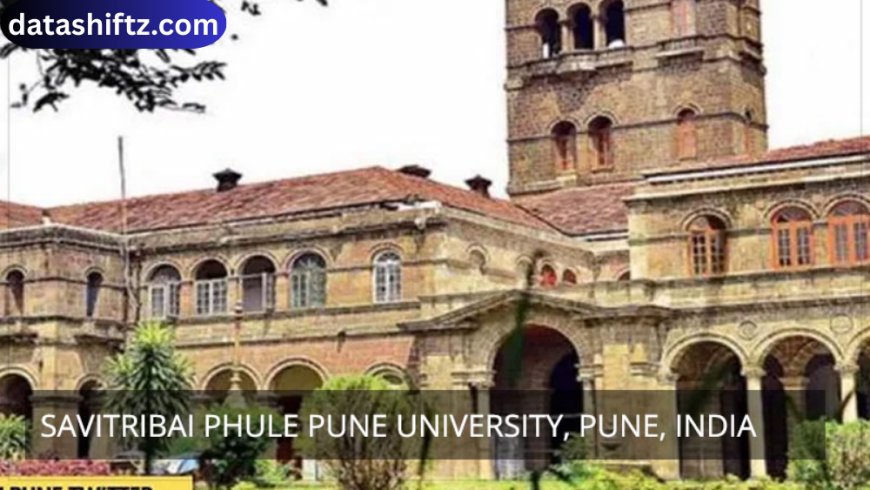Savitribai Phule Pune University – A Legacy of Excellence in Education

Introduction
Savitribai Phule Pune University (often abbreviated as SPPU), formerly the University of Pune, is one of India’s most prestigious and long‑standing universities. Since its establishment in 1949, SPPU has been a center of higher learning, research, cultural exchange, and social development. Located in Pune, Maharashtra, the university has a broad mandate—offering undergraduate, postgraduate, and doctoral programs across a wide array of disciplines, affiliating hundreds of colleges, and fostering innovation.
Named in honour of Savitribai Phule, a pioneering social reformer and advocate of women’s education and equality, the university not only carries a strong academic tradition but also a commitment to social justice. In this article, we explore its history, academic structure, recent developments, departments, and the challenges it faces—along with the opportunities it offers to students and society.
History and Background
Founding & Renaming
-
Establishment: The university was founded under the Poona University Act, coming into being on 10 February 1949, originally called the University of Poona.
-
Renaming: In 2014, the State Government of Maharashtra renamed it to Savitribai Phule Pune University in recognition of Savitribai Phule’s contributions to women’s education and social reform.
Jurisdiction & Growth Over Time
-
Initially, the university had jurisdiction over 12 districts in western Maharashtra. After reorganization (e.g., establishment of other universities), its jurisdiction is presently over fewer districts.
-
From its modest beginnings—with about 18 colleges and ~8,000 students—it has expanded to affiliate hundreds of colleges, research institutes, and thousands of students across disciplines.
Academic Structure & Departments
Faculties, Departments, & Research Centres
SPPU is recognized for both breadth and depth in academia:
| Category | Number |
|---|---|
| Academic Departments / Centres | ~ 61 departments / centres |
| Research Institutes / Recognised Institutions | ~ 234 recognised research institutes |
| Affiliated / Recognised Colleges | ~ 900 colleges under affiliation |
| Interdisciplinary / Innovation Centres | Multiple, e.g., Design Innovation Centre etc. |
-
The university offers courses in Sciences, Arts, Social Sciences, Law, Management, Commerce, Technology, among others.
-
It supports postgraduate study, doctoral supervision, and hosts many research programmes and seminars.
Student Life, Campus, & Facilities
Campus & Infrastructure
-
The main campus spans about 411 acres in the northwest of Pune city.
-
SPPU has well‑equipped libraries, seminar halls, sports facilities, hostels (though there are concerns about capacity—more on that later), and research labs.
Emblem, Motto & Identity
-
Emblem: Features Shaniwar Wada (historic palace), symbols like horses, pens, open book, etc. It encapsulates the idea of combining tradition, knowledge, and action.
-
Motto: "Where Actions Prove Knowledge" – the idea that knowledge is validated through action.
Recent Developments & Performance
Rankings and Accreditations
-
SPPU has maintained high reputation, having been NAAC re‑accredited at “A+” level.
-
It was ranked among the top universities by various ranking bodies. However, in the most recent NIRF (2025), SPPU saw a drop, slipping from 37th to 91st in overall national ranking, and from 23rd to 56th in the university category.
Recent News, Challenges, and Improvements
-
Fee changes: SPPU raised examination fees by 20% from academic year 2025‑26, the first hike in seven years. This decision is tied to implementation of NEP 2020 and changes in evaluation/examination processes.
-
Certificate security: The university is updating its degree certificates with enhanced security features; in partnership with Indian Security Press, the new certificates will have 16 security features up from the previous six.
-
Hostel & infrastructure gap: A recent survey of PG students revealed financial strain due to lack of hostel seats, especially for economically disadvantaged students; calls for improved housing facilities.
Key Facts & Figures at a Glance
| Feature | Detail |
|---|---|
| Founding Date | 10 February 1949 under Poona University Act |
| Original Name | University of Poona |
| Renamed | 2014, to Savitribai Phule Pune University |
| Jurisdiction (current) | Pune, Ahmednagar, Nashik (some districts changed) |
| Academic Departments / Centres | ~ 61 |
| Affiliated Research Institutes | ~ 234 |
| Affiliated Colleges | ~ 900 |
| NAAC Accreditation Level | A+ |
| Recent Changes | Exam fee hike, secure degree paper, hostel shortage |
Opportunities & Challenges
Strengths & Opportunities
-
Legacy & Reputation: With over seven decades of history, SPPU has deep roots, strong alumni, and academic credibility.
-
Research Potential: Large number of research centres, interdisciplinary departments, and scope for innovation.
-
Diverse Courses: From arts to sciences, emerging fields, and inter‑disciplinary programs.
-
Renaming & Social Relevance: Its association with Savitribai Phule underscores values of inclusion, women’s education, caste equity—this identity continues to resonate and shape its direction.
Challenges
-
Declining Rankings: Recent dip in NIRF rankings highlight issues such as faculty‑student ratios, research output, infrastructure support.
-
Infrastructure Strain: Hostels, student housing, especially for students from far regions, feel the pinch. Financial burdens due to lack of affordable accommodation have been reported.
-
Fee Increases & Accessibility: Any hike (examination fees, etc.) can impact students from rural or economically weaker sections. Ensuring affordability is important.
-
Maintaining Research Output: As student intake increases and teaching load rises, keeping research productivity high is a balancing challenge.
What Prospective Students Should Know
Here are key points to keep in mind for those considering SPPU for higher education:
-
Check Department Rankings & Faculties: Some departments are stronger in research or infrastructure—look up recent publications, faculty profiles.
-
Affiliated Colleges vs. Main Campus: Know whether your course is on main campus or at an affiliated college—this can affect resources, faculty access, and exposure.
-
Apply Early & Keep Documents Ready: Admission, hostel, and scholarship deadlines can be tight—keep academic records, identity proofs etc., updated.
-
Cost of Studying: Factor in not just tuition but living, hostel (if available), transport, exam fees (especially after recent fee hike).
-
Scholarship & Financial Aid: SPPU offers scholarships for eligible students; exploring state Govt & central Govt scholarships is advisable.
-
Campus Amenities: Research labs, library access, labs for sciences, sports, student clubs—these enhance overall educational experience.
-
Alumni & Networking: Being located in Pune, a major educational hub, means good exposure, internship opportunities, industry connections.
Conclusion
Savitribai Phule Pune University is more than an academic institution—it is a symbol of resilience, social reform, and academic evolution. From its establishment in 1949 to its renaming in honour of a visionary reformer, to its current standing among India’s top universities, SPPU continues to play a pivotal role in shaping educated, socially aware citizens.
While it enjoys strengths in heritage, course diversity, and research capacity, it also faces ongoing challenges like maintaining high rankings, infrastructure, and accessibility. For students, researchers, and educators, SPPU offers a fertile ground, provided one navigates its resources smartly and stays informed of its developments.





























